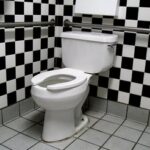Most people are familiar with the traditional way to unclog a toilet. That is, the do-it-yourself method which only utilizes a bell-shaped toilet plunger. Well, if you haven’t heard by now, there’s a popular variation to that typical DIY method of plunging. It’s the addition of Dawn dishwashing liquid and hot water. I know, an unexpected combination of plumbing materials, but hey, it works. In my opinion, (and probably many others’ as well), this way is the best way. In fact, what I’m about to share with you will hopefully bring some relief to you, especially if you’re the one that’s stuck with handling this predicament. You’ll also be happy to hear that there’s no need to spend unnecessary money on plumbing service when you can easily do this yourself using inexpensive household items.
Okay, now let’s get started with the following preparation. The first thing to do is turn off the toilet’s water supply by turning the knob on the end of the valve clockwise. (This knob is located in the back of the toilet fixture, down near the floor). Then take the tank’s lid off as you may need to access the rubber flap- (in case the water level starts to rise).
Aside from a bottle of Dawn, you’ll need a pot full of hot water. Optimally, the water should be very hot, but preferably not boiling hot. You could heat the water in a big pot on the stove, but make sure it’s taken off the stove right before it starts to boil.
As for the toilet bowl, it’s better to wait a couple minutes if the water level is too high because you need it to be as low as possible. And quite often, the water level does go down by itself, albeit extremely slowly at times, depending on the severity of the blockage.
After waiting, and when it is somewhat lower, pour about a third to half a cup of Dawn into the toilet bowl. Let it sit for a few minutes. Then, if the toilet bowl’s water level is at least two-thirds of the way down, carefully pour a pot full of hot water (from about the height of your hips) into the bowl. Try to pour it fast while aiming at the hole.
At this point, you’ll probably notice the level starting to go down a bit faster. Sometimes the contents in the toilet flush down immediately, but most times it’ll take a few repeats of the steps in order for it to instantly flush. However, each time you repeat the process, it should go down faster than the previous attempts. (Using the plunger is also recommended as it does help to loosen the blockage.)
When you notice the water going down instantly (after pouring the hot water in), the clog is most likely loosened enough for the toilet to start flushing on its own. But, to be on the safe side, with the water flow valve still turned off, try to flush the toilet using its handle. If the toilet flushes normally, it has finally become unclogged. However, if you see the water level rising up, very quickly reach into the tank (where the bulb, chain and rubber flap is located), and gently press down on the rubber flap to close it. Keep your hand on it until you see the bowl water leveling off, or going down. Don’t take your hand off of the flap until the level goes way down- and then when the level is low again, you can take your hand off the flap, and proceed to use the plunger.
Again, repeat the steps until the toilet bowl water goes down instantly (and fast) for at least two or three times. Then turn on the water supply valve. Do the handle flush test again, while simultaneously being prepared to quickly hold the rubber flap down, if needed. By now, though, it should be able to flush on its own.
Note that the length of the entire process weighs heavily on how severe the blockage is. If the clog is caused by an object such as a toy, then it would warrant a call to a plumber.





